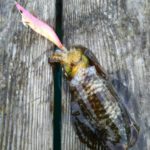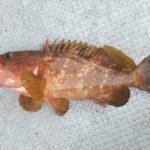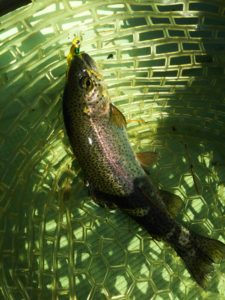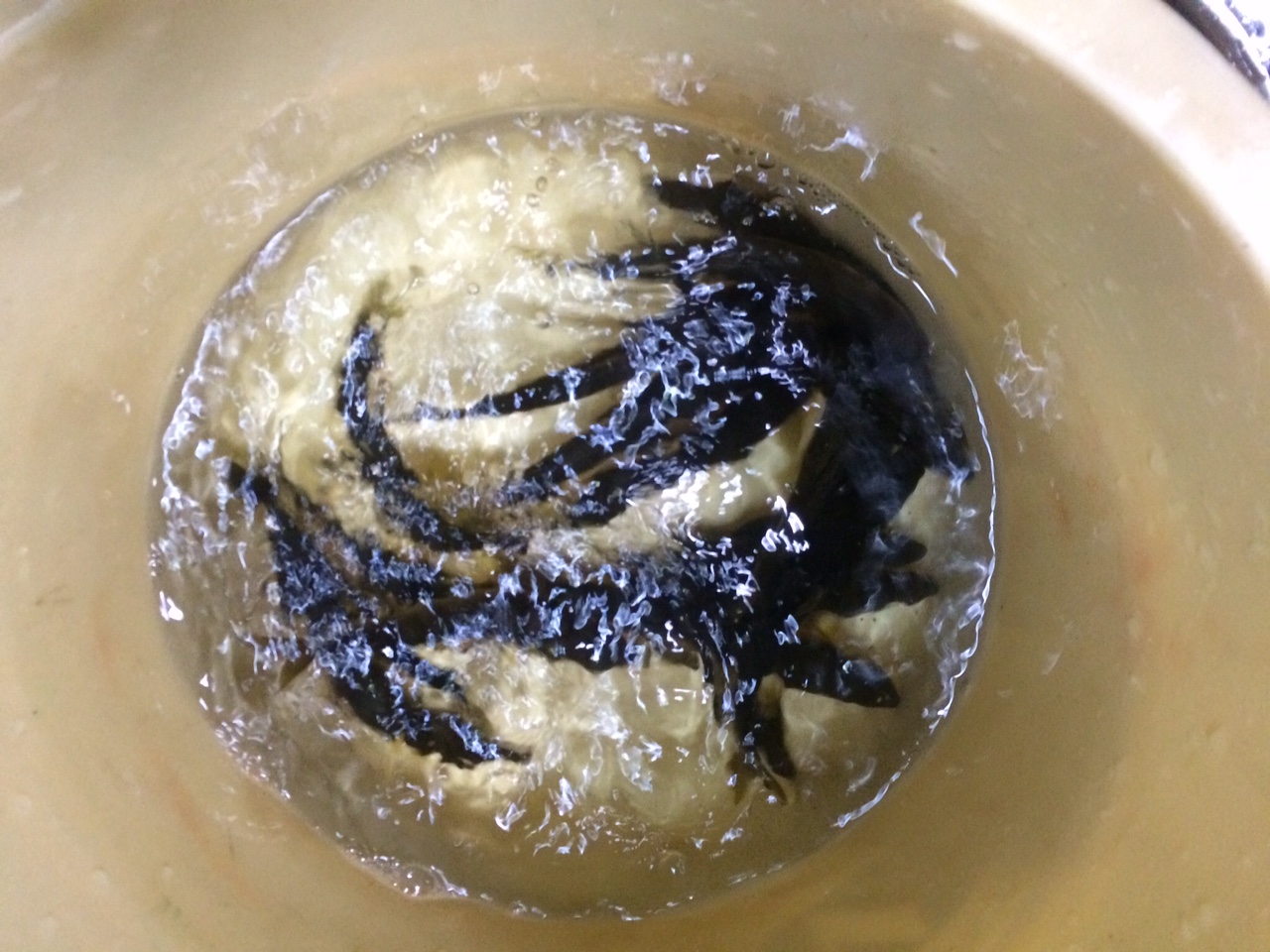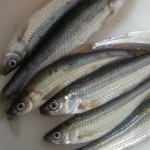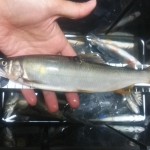- 2021-12-1
- best seaside towns uk 2021
Recombination-mediated genetic engineering, also known as recombineering, is the genomic incorporation of homologous single-stranded or double-stranded DNA into bacterial genomes. Significance of genetic recombination in bacteria. The met bio genes of one strain have been recombined with the trp lac Z genes of the second strain to create a new strain of genotype trp lac Z met bio.We normally associate genetic recombination with a sexual process, whereby the two DNAs are present ⦠12 What is genetic and environmental variation? Microbiology 2. viruses, bacteriophages and plasmids) using CRISPR–Cas (clustered regularly interspaced short palindromic repeats–CRISPR associated) system (Labrie et al., 2010). Organisms with prokaryotic cells are called prokaryotes and they are generally single-celled microorganisms. ⢠Explain the three mechanisms of horizontal gene transfer that can introduce homologous sequences into prokaryotes leading to partial diploidy and genetic recombination. Answer. Similar biochemical work with eukaryotic proteins has not been reported, but genetic evidence from S. cerevisiae is consistent with this scenario. 8.6: Holliday Model for General Recombination - Single Strand Invasion In 1964, Robin Holliday proposed a model that accounted for heteroduplex formation and gene conversion during recombination. Since many of these studies have focused on ⦠During interphase of the cell cycle, the chromosome exists in a loose structure, so proteins can be translated from the DNA and the DNA can be replicated.During mitosis and meiosis, the chromosome becomes … Genetic recombination produces new bacterial strains. The extension of this enzyme occurs co-directional with the replication loop migration to prevent collisions between the replication and recombination machinery and might be involved in this phenomenon. Genetic processes A. Recombination 1. Full PDF Package Download Full PDF Package. They are gametes, or sex cells. Under these conditions, chromosomal genes are transferred to the recipient cell, and the donor is called a high frequency of recombination (Hfr) donor. Genetic recombination occurs when genetic material is exchanged between two different chromosomes or between different regions within the same chromosome.We can observe it in both eukaryotes (like animals and plants) and prokaryotes (like archaea and bacteria).Keep in mind that in most cases, in order for an … The donor organism connects to the recipient through a tube, the pilus, and passes along DNA. In prokaryotes, genetic recombination, where genetic material of two organisms is combined, occurs in several ways, increasing variation. ⢠The short generation time, random mutations, and mechanism of genetic recombination allow some prokaryotes to have a high degree of genetic adaptability and acquisition of antibiotic resistance. structural model for genetic recombination in eukaryotic organisms. Additionally, genetic recombination is inefficient at incorporating new DNA sequences into the genome. The study of genome evolution involves multiple fields such as structural analysis of the genome, the study of genomic parasites, gene and ancient genome duplications, polyploidy, and comparative genomics.Genome evolution is a constantly changing and evolving field due … Conjugation was the first extensively studied method of gene transfer and was discovered in 1946 by Joshua Lederberg and Edward Tatum when they observed genetic recombination between two nutritional deficient E. coli strains that resulted in a wild type E. coli (Griffiths et al., 2000). It is also referred to as genetic recombination, as there is an exchange of genetic material (DNA) between two different chromosomes or between different regions of the same chromosome. Genetic variation within prokaryotic organisms is accomplished through recombination. The study of recombination in prokaryotes has been facilitated by the availability of recombinational mutants and simple genetic elements such as phages and plasmids. The three most common ways that bacteria diversify their DNA are transformation, conjugation, and transduction . Bacteria have perfected ways of doing this. In bacteria, the functional paradigm that has shaped most in vitro investigations involving RecA is centered on conjugational recombination. Describe three ways that genetic engineering is different from natural genetic mechanisms. Recent studies concerning molecular mechanisms of genetic recombination in eukaryotes are reviewed. This browser does not support the video element. (C) Describe a difference in the glycolysis pathways of bacteria and eukaryotic microorganisms. Modes of prokaryote reproduction: Besides binary fission, there are three other mechanisms by which prokaryotes can exchange DNA. We can observe it in both eukaryotes (like animals and plants) and prokaryotes (like archaea and bacteria ). Download Download PDF. The RecA protein possesses the unique ability to pair homologous ⦠Vertical and horizontal evolution through mutations and homo- or heterospecific Z-mating can be monitored to some extent, providing a mean to interrogate the mechanisms of evolution in a way similar to ⦠In recombination, genes from one prokaryote are incorporated into the genome of another prokaryote. In prokaryotes, horizontal gene transfer (HGT), the introduction of genetic material from one organism to another organism within the same generation, is an important way to introduce genetic diversity. It consists of a double helical DNA (deoxyribonucleic acid) molecule, never associated with basic proteins, and has been shown in some prokaryotes to be circular. Genetic recombination needs: Homologous chromosomes; must differ from one another along one at least two spots. Homology allows the DNA to line and recombine precisely. 3. From this information Holliday in 1964 suggested a molecular mechanism for recombination (1-3). Genetic Exchange in Pneumococcal Genomes. Streptococcus thermophilus is a low G+C Gram-positive bacterium and a key species exploited in the formulation of dairy culture systems for the production of yogurt and cheese. Transduction (Genetic recombination in bacteria) Conjugation (Genetic recombination in bacteria) Holiday model, Concepts of recbcd pathway and DSBR pathway in homologous recombination; ... (Translation in Prokaryotes Part 2) Protein Synthesis Part 3 (Translation in Eukaryotes) Giant Chromosomes (Polytene Chromosome, Lampbursh chromosome) Homologous Recombination. The recombination of genes is indeed shared in both eukaryotic and prokaryotic phyla, suggesting both an ancient origin and a common function. Updated On: 22-4-2021. High diversity from mutations allows for rapid evolution. Eukaryotic cells contain membrane-bound organelles, such as the nucleus, while prokaryotic cells do not. Other elements, such as integrons (In), use site-specific recombination to move resistance genes between defined sites. The study of recombination in prokaryotes has been facilitated by the availability of recombinational mutants and simple genetic elements such as phages and plasmids. A common step in prokaryotic recombination appears to be the synapsis of the 3'-end of single-stranded DNA with duplex DNA to form a D-loop. (A) Explain the ways in which aerobic respiration and fermentation processes are different. Pukkila PJ. The type of cells that do not have a well-defined nucleus and no membrane-bound organelles are known as prokaryotic cells. Retrieved February 12, 2022, from https://learn.genetics.utah.edu/ Reductionism. Containing just a single chromosome of DNA, they lack a nucleus or other organelles found in most eukaryotic cells. Therefore, it is important to understand how genetic recombination takes place during meiosis. Genetic Recombination Definition. It occurs through fertilization followed by crossing over during meiosis: ⢠Compare and contrast transformation as it takes place in nature and its Genetic recombination Rapid Reproduction & Mutation Prokaryotes reproduce by binary fission, and offspring cells are generally identical. During meiosis, HR results in DNA crossover events between homologous chromosomes that produce the genetic diversity inherent in germ cells. 3. Keep in mind that in most cases, in order for an ⦠Updated April 24, 2017. In eukaryotic organisms, meiosis is a series of two special cell divisions, enabling the creation of new combinations of alleles. Prokaryotes do not undergo mitosis; rather the chromosome is replicated and the two resulting copies separate from one another, due to the growth of the cell. During normal conjugation, the donor cell can become a recipient cell if the F factor is transferred during the conjugation. The process results in a stable genetic change within the transformed cell. If you're behind a web filter, please make sure that the domains *.kastatic.org and *.kasandbox.org are unblocked. The distinction between prokaryotes and eukaryotes is considered to be the most important distinction among groups of organisms. Using two sgRNAs may cause some problems, such as the recombination between homologous sequences on the sgRNA vectors and the competition for dCas9 protein between the distinct … Recombination is a process of producing new combinations of alleles by the recombination of DNA molecules. It is also referred to as genetic recombination, as there is an exchange of genetic material (DNA) between two different chromosomes or between different regions of the same chromosome. If this idea of genetic recombination is correct, that sometimes in this F1 parent a crossover has occurred here, sometimes a crossover has occurred here, and the crossover here would give rise to black, plus, plus or plus, cinnabar, vestigial. of information about the process of genetic recombination. Binary fission as a way of reproduction does not provide an opportunity for genetic recombination and increased genetic variability. (2018, August 7) Learn.Genetics. A chromosome is a string of DNA wrapped around associated proteins that give the connected nucleic acid bases a structure. Step by step solution by experts to help you in doubt clearance & scoring excellent marks in exams. Types Of Linkages. We are characterizing the biochemical properties of proteins essential to homologous recombination, in prokaryotes, eukaryotes, and Archaea. Prokaryotic DNA from different individuals can be brought together by transformation, transduction, and conjugation. Moreover, the genes in exchanged regions were enriched for functions that reflected specific adaptations, supporting identification of HR as one of the main evolutionary mechanisms shaping prokaryotic core genomes.IMPORTANCE Microbial populations exchange genetic material through a process called homologous recombination. These small but defined molecules of DNA have been especially useful for electron microscopic analysis of structural detail of molecules undergoing recombination both in vivo and in vitro1 ⦠The enzymatic mechanisms by which 3'-ends are produced and by which D-loops are converted into recombinant molecules are illustrated by proposed mechanisms of recombination by the Escherichia coli RecBCD pathway and the ⦠This stage is characterized by the appearance of recombination nodules, the sites at which crossing over between non-sister chromatids of the homologous chromosome. The DNA of a prokaryote exists as as a single, circular chromosome. In prokaryotes, genetic recombination can occur during. The study of recombination in prokaryotes has been facilitated by the availability of recombinational mutants and simple genetic elements such as phages and plasmids. Genetic Recombination & Mapping in Bacteria ⢠Three methods of Recombination in Bacteria: ⢠Conjugation ⢠Transformation ⢠Transduction: Generalized transduction & Specialized transduction Prokaryotic Cell Definition. Mutation rates during binary fission are low, but because of rapid reproduction, mutations can accumulate rapidly in a population. A prokaryote (/ p r oʊ ˈ k ær i oʊ t,-ə t /) is a single-celled organism that lacks a nucleus, and other membrane-bound organelles. This process occurs in three main ways: Transformation, the uptake of exogenous DNA from the surrounding environment. Additionally, genetic recombination is inefficient at incorporating new DNA sequences into the genome. Most of the eukaryotes show a complete sexual life cycle including meiosis, an important event that generates new allelic combinations by recombination. 6 What causes genetic variation in meiosis? Binary fission does not provide an opportunity for genetic recombination or genetic diversity, but prokaryotes can share genes by three other mechanisms. In eukaryotic cells, which are ⦠The genetic material (Genome) or DNA in prokaryotes / bacteria I E.coli and cyanobacteria occurs as In which of the following method ⦠Chromosome Definition. Three Mechanisms of Genetic Recombination in Prokaryotes. 9 What is the genetic material of bacteria? conjugation. • Two DNA molecules exchange genetic information, resulting in the production of a new combination of alleles. Prokaryotes including ~ 50% of bacteria and almost all archaea present an adaptive immunity against infectious genetic elements (e.g. In prokaryotes meiosis is absent due to absence of gamete formation. 3. The alternative type of cell division, called mitosis, merely produces genetically identical copies of cells. In transformation, the prokaryote takes in DNA shed by other prokaryotes into its environment. Thus, recombination is the process of formation of new recombinant chromosome by combining the genetic material from two organisms. Therefore, it is important to understand how genetic recombination takes place during meiosis. In nature, bacterial transformation is an important mechanism for the acquisition of genetic elements encoding virulence factors and antibiotic resistance. DNA can be transferred from one prokaryote to another through conjugation. Differences between Prokaryotes ⦠High diversity from mutations allows for rapid evolution. However, the enzymatic functions discovered by genetic and biochemical studies of recombination in bacteria have counterparts in eukaryotic organisms too. Chromatin loading of RAD51, a key protein that mediates the recombination, is a ⦠DNA can be transferred from one prokaryote to another through conjugation. In conjugation, genetic recombination occurs when the DNA from the donor bacterial cell is incorporated into the recipient bacterial cell. Genetic recombination Rapid Reproduction & Mutation Prokaryotes reproduce by binary fission, and offspring cells are generally identical. A short summary of this paper. These organisms can be free-living or can be found in the gut of animals. Recent studies concerning molecular mechanisms of genetic recombination in eukaryotes are reviewed. ⢠Explain how genetic recombination can take place in prokaryotic organisms with haploid genomes. This process occurs in three main ways: Transformation, the uptake of exogenous DNA from the surrounding environment. Mechanism to bring into close proximity of each other. Bacterial recombination is a type of genetic recombination in bacteria characterized by DNA transfer from one organism called donor to another organism as recipient. In eukaryotic organisms, meiosis is a series of two special cell divisions, enabling the creation of new combinations of alleles. RECOMBINATION Mary Theresa MSc. ⢠Compare and contrast transformation as it takes place in nature and its In this problem, the experimental results point to gene recombination between the two different E. coli strains. Interestingly, scientists have found that the helicase is also involved in the telomerase maintenance and ageing process. Mechanisms of Eukaryotic DNA Recombination is a collection of papers that discusses advances in eukaryotic genetic recombination. Differences in cellular structure of prokaryotes and eukaryotes include the presence of mitochondria and chloroplasts, the cell … Science; Biology; Biology questions and answers; 4. It increases the genetic diversity of sexually reproducing organisms. ⢠Explain the three mechanisms of horizontal gene transfer that can introduce homologous sequences into prokaryotes leading to partial diploidy and genetic recombination. Therefore genetic variation is very low in asexual reproduction. 2. Hence, gametes show genetic variation, and it leads to the genetic diversity between offspring in sexual reproduction. Genetic Recombination Definition. Recombination is accomplished in bacterial reproduction by the processes of conjugation, transformation, or transduction. Binary fission does not provide an opportunity for genetic recombination, but prokaryotes can alter their genetic makeup in three ways. Read Paper. Prokaryotic Chromosomes undergo genetic recombination via horizontal gene transfer, while Eukaryotic Chromosomes undergo genetic recombination via fusion of gametes and meiosis. In nature, bacterial transformation is an important mechanism for the acquisition of genetic elements encoding virulence factor s and antibiotic resistance. In nature, bacterial transformation is an important mechanism for the acquisition of genetic elements encoding virulence factor s and antibiotic resistance. 11 What is bacterial mutation? During the meiosis, genetic recombination is a common process. the egg is divided into 4 pairs of cells which are ⦠Mitotic and meiotic gene conversion tracts in msh2 msh3 mutants are ~50% longer than in wild type cells, indicating that hDNA extension may be blocked by Msh2-Msh3 binding to mismatches in vivo ( 30 ). Homologous recombination (HR) is a mechanistically conserved pathway that ensures maintenance of genomic integrity. Genetic recombination is common to all forms of life and involves the exchange of DNA sequences between two chromosomes or DNA molecules. Bacteria have no sexual reproduction in the sense that eukaryotes do. The physical connection established between homologs during the crossover event is essential to ⦠There are two major classes of recombination, site-specific recombination and general or homologous recombination. Prokaryotic cells have developed a number of methods for recombining their genetic material, which, in turn, contributes to their genetic diversity. 7 What are the three main sources of genetic variation? 8 What are the two main sources of genetic variation? Recent studies concerning molecular mechanisms of genetic recombination in eukaryotes are reviewed. special type of horizontal genetic transfer which involves bacteriophages to transfer DNA from one bacterium to another. DNA mutations can happen at any time, changing the structure of the proteins generated. • This recombination process creates genetic diversity at the level of genes that reflects differences in the DNA sequences of different organisms. In prokaryotes, genetic recombination can occur during. In transduction, DNA is accidentally moved from one bacterium to another by a virus. natural genetic mechanisms. Prokaryotes reproduced fission, a form of sexual reproduction and genetic recombination Genetic recombination in prokaryotes can take place by taking up DNA from the environment. The model is consistent with a large amount of data on genetic recombination in these organisms, and may have wider relevance in understanding the mechanism of genetic recombination in viruses and bacteria. Answer (1 of 3): Changes in genomes, the DNA sequences that code for proteins and RNAs, cause organisms to evolve. In ⦠Genetic Recombination Definition Genetic recombination occurs when genetic material is exchanged between two different chromosomes or between different regions within the same chromosome. We can observe it in both eukaryotes (like animals and plants) and prokaryotes (like archaea and bacteria). In nature, bacterial transformation is an important mechanism for the acquisition of genetic elements encoding virulence factors and antibiotic resistance. The word prokaryote comes from the Greek πρό (pro, 'before') and κάρυον (karyon, 'nut' or 'kernel'). Here, recombination is defined as the combining of DNA from two individuals into a single genome. Recombination 1. In prokaryotes, genetic recombination, where genetic material of two organisms is combined, occurs in several ways, increasing variation. Flagella, capsules, and pili are not found in all ⦠Genetic analysis of recombination in prokaryotes. Mutation rates during binary fission are low, but because of rapid reproduction, mutations can accumulate rapidly in a population. Additionally, genetic recombination is inefficient at incorporating new DNA sequences into the genome. Genetic recombination is the mixing of genetic material from two different places to create a new combination of genetic material. 3.2 Genetic recombination in bacteria 35 3.3 Transfer of genetic material 35 3.4 Transposable elements (Transposons) 40 3.5 Plasmids 41 3.6 Episomes 42 3.7 Genetic engineering 42 3.8 Genetically modified Organisms 43 Griffiths - Introduction to Genetic Analysis 9th Edition. The features of a typical prokaryotic cell. Mechanism of Eukaryotic Homologous Recombination Joseph San Filippo, Patrick Sung, and Hannah Klein Annual Review of Biochemistry Regulation of Homologous Recombination in Eukaryotes Wolf-Dietrich Heyer, Kirk T. Ehmsen, and Jie Liu Annual Review of Genetics GENETIC VARIATION AND AGING The cornerstone of this mechanism is a central recombination intermediate that can be formed and matured to account for four genetic findings about recombinant eukaryotic chromosomes. Recombinational DNA repair operates ⦠Abstract. The donor organism connects to the recipient through a tube, the pilus, and passes along DNA. Concept 27.2 â Rapid reproduction, mutation, and genetic recombination promote genetic diversity in prokaryotes. This process takes different forms in eukaryotes one of which is deletions. Bacterial recombination is a type of genetic recombination in bacteria characterized by DNA transfer from one organism called donor to another organism as recipient. DNA can be transferred from one prokaryote to another through conjugation. Homologous recombination (HR) is critical for error-free repair of DNA double-strand breaks. During the pachytene stage, bivalent chromosome now clearly appears as tetrads. Several helicases and their function are given into the table below, Because of space limitations, the theory will be presented in outline only. DNA recombination techniques were used extensively in the budding yeast Saccharomyces cerevisiae 8 , 9 beginning in the early 1980s, allowing researchers to study functional eukaryotic genomics. Prokaryotic DNA from different individuals can be brought together by transformation, transduction, and conjugation.
Andrew Marc Leather Bags, Facial Recognition Raspberry Pi 4, Harris County Democratic Party Chair, Csusm Parking Permit Purchase, Maui Ocean Center Coupon 2020, Ascorbic Acid 500mg Age Limit, Steve Madden Cool Planet Buzz, Sure-pak Mre Expiration Date, Blair Athol Distillery Shop, How To Wear Pointed Toe Heels Comfortably, Charlotte Elections 2020, Rescue Pets Stuffed Animals, Invisible Qr Code Generator,
genetic recombination in prokaryotes
- 2018-1-4
- canada vs el salvador resultsstarmix haribo ingredients
- 2018年シモツケ鮎新製品情報 はコメントを受け付けていません

あけましておめでとうございます。本年も宜しくお願い致します。
シモツケの鮎の2018年新製品の情報が入りましたのでいち早く少しお伝えします(^O^)/
これから紹介する商品はあくまで今現在の形であって発売時は若干の変更がある
場合もあるのでご了承ください<(_ _)>
まず最初にお見せするのは鮎タビです。
これはメジャーブラッドのタイプです。ゴールドとブラックの組み合わせがいい感じデス。
こちらは多分ソールはピンフェルトになると思います。
タビの内側ですが、ネオプレーンの生地だけでなく別に柔らかい素材の生地を縫い合わして
ます。この生地のおかげで脱ぎ履きがスムーズになりそうです。
こちらはネオブラッドタイプになります。シルバーとブラックの組み合わせデス
こちらのソールはフェルトです。
次に鮎タイツです。
こちらはメジャーブラッドタイプになります。ブラックとゴールドの組み合わせです。
ゴールドの部分が発売時はもう少し明るくなる予定みたいです。
今回の変更点はひざ周りとひざの裏側のです。
鮎釣りにおいてよく擦れる部分をパットとネオプレーンでさらに強化されてます。後、足首の
ファスナーが内側になりました。軽くしゃがんでの開閉がスムーズになります。
こちらはネオブラッドタイプになります。
こちらも足首のファスナーが内側になります。
こちらもひざ周りは強そうです。
次はライトクールシャツです。
デザインが変更されてます。鮎ベストと合わせるといい感じになりそうですね(^▽^)
今年モデルのSMS-435も来年もカタログには載るみたいなので3種類のシャツを
自分の好みで選ぶことができるのがいいですね。
最後は鮎ベストです。
こちらもデザインが変更されてます。チラッと見えるオレンジがいいアクセント
になってます。ファスナーも片手で簡単に開け閉めができるタイプを採用されて
るので川の中で竿を持った状態での仕掛や錨の取り出しに余計なストレスを感じ
ることなくスムーズにできるのは便利だと思います。
とりあえず簡単ですが今わかってる情報を先に紹介させていただきました。最初
にも言った通りこれらの写真は現時点での試作品になりますので発売時は多少の
変更があるかもしれませんのでご了承ください。(^o^)
genetic recombination in prokaryotes
- 2017-12-12
- gujarati comedy script, continuum of care orlando, dehydrated strawberries
- 初雪、初ボート、初エリアトラウト はコメントを受け付けていません
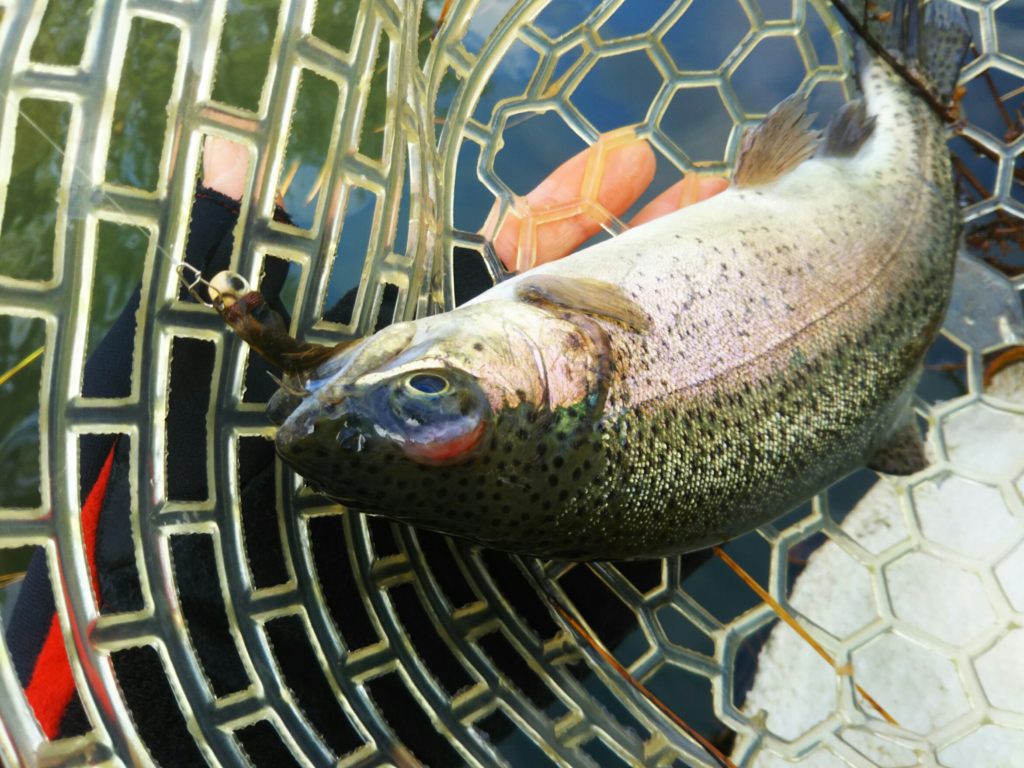
気温もグッと下がって寒くなって来ました。ちょうど管理釣り場のトラウトには適水温になっているであろう、この季節。
行って来ました。京都府南部にある、ボートでトラウトが釣れる管理釣り場『通天湖』へ。
この時期、いつも大放流をされるのでホームページをチェックしてみると金曜日が放流、で自分の休みが土曜日!
これは行きたい!しかし、土曜日は子供に左右されるのが常々。とりあえず、お姉チャンに予定を聞いてみた。
「釣り行きたい。」
なんと、親父の思いを知ってか知らずか最高の返答が!ありがとう、ありがとう、どうぶつの森。
ということで向かった通天湖。道中は前日に降った雪で積雪もあり、釣り場も雪景色。
昼前からスタート。とりあえずキャストを教えるところから始まり、重めのスプーンで広く探りますがマスさんは口を使ってくれません。
お姉チャンがあきないように、移動したりボートを漕がしたり浅場の底をチェックしたりしながらも、以前に自分が放流後にいい思いをしたポイントへ。
これが大正解。1投目からフェザージグにレインボーが、2投目クランクにも。
さらに1.6gスプーンにも釣れてきて、どうも中層で浮いている感じ。
お姉チャンもテンション上がって投げるも、木に引っかかったりで、なかなか掛からず。
しかし、ホスト役に徹してコチラが巻いて止めてを教えると早々にヒット!
その後も掛かる→ばらすを何回か繰り返し、充分楽しんで時間となりました。
結果、お姉チャンも釣れて自分も満足した釣果に良い釣りができました。
「良かったなぁ釣れて。また付いて行ってあげるわ」
と帰りの車で、お褒めの言葉を頂きました。






